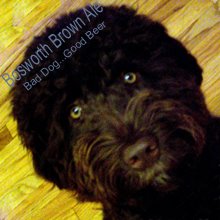
I didn't know what I was going to call this beer until I realized what it is ready for. Opening Day of Major League Baseball. What is better than kicking back to watch America's pastime drinking a malty hoppy dark German ale? OK, so that doesn't really make sense, but this is the beer I made, and it's officially ready today, and besides, as you'll see from the recipe below, at least I used American hops.
This beer is the ale component of the split batch ale/lager strategy I've been using lately. It was made using the second and third runnings of the mash used to make Obfuscator Doppelbock. It was made in the style of a Dusseldorf alt, and again using American hops instead of noble German hops. So here is the recipe:
15lbs Dark German Munich malt
8lbs American two-row (I would have used Vienna malt, but I've got a ton of two-row on hand)
1lb Carahelles (a free gift from Larry at the LHBS--it was a sample from their supplier)
1lb Melanoidin malt
1/2 lb U.K. pale chocolate malt
1lb DME
1lb corn sugar
1 oz Galena 13.1% AA hops
1 oz Columbus 12% hops (need to cut this in half)
Dry ale yeast (I forget which one I used)
Mash at 146F for one hour and collect the 2nd and 3rd runnings to collect approximately 12 gallons of wort. Pre-boil gravity was 1.033. The hop schedule was:
Galena 60 minutes
Columbus 30 minutes
The alt turned out too bitter for a number of reasons. One, the gravity came in much lower than expected, so I got much better hop utilization rates. (The less sugary your wort, the more the bitterness is extracted from the hops). Two, I intended to only add 0.5 ounces of the Columbus, but I left in the middle of the boil due to a family emergency, and mistakenly added a full ounce. And three, I had only intended to boil the columbus hops for 15 minutes, instead of 30, again because I left in a hurry. I also didn't add Irish moss as usual during the last 15 minutes of the brew.
The cooling of the wort was done in a very interesting way. I instructed the wifey to turn off the burner at the proper time, since I wasn't going to be there. The wort sat outside, uncovered for about 3 hours before I was able to return. It dropped from boiling to about 115F during this time. Probably the ultimate temperature for beer spoiling organisms. But I didn't have a choice--this reminds me, I need to buy a cover for my 15 gallon brew kettle. At this point, I force chilled it down to 65F with my immersion chiller, pitched the yeast and hoped for the best.
The O.G. came in at 1.038 (low for style), so I added the corn sugar and malt extract (after boiling them in a half gallon of water for 15 minutes) two days into fermentation, bringing the estimated O.G. to 1.048. Normally I wouldn't add sugar to an alt, but I was down to my last pound of DME, and I needed to make it a little stronger. It fermented for 10 days at approximately 65F.
So how is it? Well, as I mentioned earlier, it's too bitter, although you get used to it after the second pint. It's also very cloudy. Alts are supposed to be very clear, and mine is not. I don't know if it's because I didn't add the Irish moss, or because it didn't cool quickly, or what, but this beer is kind of a muddy brown. More like a muddy brownish-orange. Yes, I know it sounds appetizing. So it looks like this one is going to be for my own enjoyment, no competition winner here. But it's like my buddy Mikey says, "There are no bad homebrews, some are just more preferred than others".
This beer is the ale component of the split batch ale/lager strategy I've been using lately. It was made using the second and third runnings of the mash used to make Obfuscator Doppelbock. It was made in the style of a Dusseldorf alt, and again using American hops instead of noble German hops. So here is the recipe:
15lbs Dark German Munich malt
8lbs American two-row (I would have used Vienna malt, but I've got a ton of two-row on hand)
1lb Carahelles (a free gift from Larry at the LHBS--it was a sample from their supplier)
1lb Melanoidin malt
1/2 lb U.K. pale chocolate malt
1lb DME
1lb corn sugar
1 oz Galena 13.1% AA hops
1 oz Columbus 12% hops (need to cut this in half)
Dry ale yeast (I forget which one I used)
Mash at 146F for one hour and collect the 2nd and 3rd runnings to collect approximately 12 gallons of wort. Pre-boil gravity was 1.033. The hop schedule was:
Galena 60 minutes
Columbus 30 minutes
The alt turned out too bitter for a number of reasons. One, the gravity came in much lower than expected, so I got much better hop utilization rates. (The less sugary your wort, the more the bitterness is extracted from the hops). Two, I intended to only add 0.5 ounces of the Columbus, but I left in the middle of the boil due to a family emergency, and mistakenly added a full ounce. And three, I had only intended to boil the columbus hops for 15 minutes, instead of 30, again because I left in a hurry. I also didn't add Irish moss as usual during the last 15 minutes of the brew.
The cooling of the wort was done in a very interesting way. I instructed the wifey to turn off the burner at the proper time, since I wasn't going to be there. The wort sat outside, uncovered for about 3 hours before I was able to return. It dropped from boiling to about 115F during this time. Probably the ultimate temperature for beer spoiling organisms. But I didn't have a choice--this reminds me, I need to buy a cover for my 15 gallon brew kettle. At this point, I force chilled it down to 65F with my immersion chiller, pitched the yeast and hoped for the best.
The O.G. came in at 1.038 (low for style), so I added the corn sugar and malt extract (after boiling them in a half gallon of water for 15 minutes) two days into fermentation, bringing the estimated O.G. to 1.048. Normally I wouldn't add sugar to an alt, but I was down to my last pound of DME, and I needed to make it a little stronger. It fermented for 10 days at approximately 65F.
So how is it? Well, as I mentioned earlier, it's too bitter, although you get used to it after the second pint. It's also very cloudy. Alts are supposed to be very clear, and mine is not. I don't know if it's because I didn't add the Irish moss, or because it didn't cool quickly, or what, but this beer is kind of a muddy brown. More like a muddy brownish-orange. Yes, I know it sounds appetizing. So it looks like this one is going to be for my own enjoyment, no competition winner here. But it's like my buddy Mikey says, "There are no bad homebrews, some are just more preferred than others".






